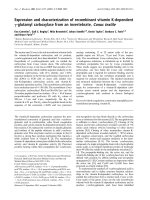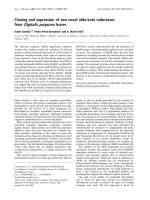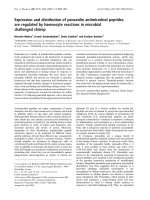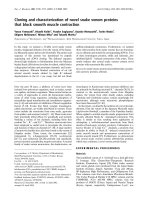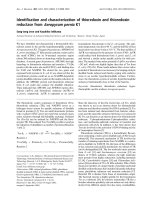Báo cáo y học: "Reclassification and Subtyping of So-called Malignant Fibrous Histiocytoma of Bone: Comparison with Cytogenetic Features" pdf
Bạn đang xem bản rút gọn của tài liệu. Xem và tải ngay bản đầy đủ của tài liệu tại đây (153.59 KB, 18 trang )
This Provisional PDF corresponds to the article as it appeared upon acceptance. Fully formatted
PDF and full text (HTML) versions will be made available soon.
Reclassification and Subtyping of So-called Malignant Fibrous Histiocytoma of
Bone: Comparison with Cytogenetic Features
Clinical Sarcoma Research 2011, 1:10 doi:10.1186/2045-3329-1-10
Fredrik Mertens ()
Salvatore Romeo ()
Judith VMG Bovee ()
Roberto Tirabosco ()
Nick Athanasou ()
Marco Alberghini ()
Pancras CW Hogendoorn ()
Angelo P Dei Tos ()
Raf Sciot ()
Henryk A Domanski ()
Kristina Astrom ()
Nils Mandahl ()
Maria Debiec-Rychter ()
ISSN 2045-3329
Article type Research
Submission date 6 September 2011
Acceptance date 13 October 2011
Publication date 13 October 2011
Article URL />This peer-reviewed article was published immediately upon acceptance. It can be downloaded,
printed and distributed freely for any purposes (see copyright notice below).
For information about publishing your research in Clinical Sarcoma Research or any BioMed Central
journal, go to
/>For information about other BioMed Central publications go to
Clinical Sarcoma Research
© 2011 Mertens et al. ; licensee BioMed Central Ltd.
This is an open access article distributed under the terms of the Creative Commons Attribution License ( />which permits unrestricted use, distribution, and reproduction in any medium, provided the original work is properly cited.
/>Clinical Sarcoma Research
© 2011 Mertens et al. ; licensee BioMed Central Ltd.
This is an open access article distributed under the terms of the Creative Commons Attribution License ( />which permits unrestricted use, distribution, and reproduction in any medium, provided the original work is properly cited.
Reclassification and subtyping of so-called malignant fibrous histiocytoma of
bone: comparison with cytogenetic features
Fredrik Mertens
1*
, Salvatore Romeo
2
, Judith VMG Bovée
3
, Roberto Tirabosco
4
, Nick
Athanasou
5
, Marco Alberghini
6
, Pancras CW Hogendoorn
3
, Angelo P Dei Tos
2
, Raf
Sciot
7
, Henryk A. Domanski
8
, Kristina Åström
9
, Nils Mandahl
1
, Maria Debiec-
Rychter
10
1
Department of Clinical Genetics, University and Regional Laboratories, Skåne
University Hospital, Lund University, Lund, Sweden;
2
Department of Pathology, Treviso Regional Hospital, Treviso, Italy;
3
Department of Pathology, Leiden University Medical Center, Leiden, The
Netherlands;
4
Department of Pathology, Royal National Orthopaedic Hospital, London, United
Kingdom;
5
Department of Pathology, Nuffield Orthopaedic Center, Oxford, United Kingdom;
6
Department of Pathology, Rizzoli Orthopaedic Institute, Bologna, Italy;
7
Department of Pathology, Catholic University of Leuven, Leuven, Belgium;
8
Department of Pathology, Lund University Hospital, Lund, Sweden;
9
Department of Pathology, Karolinska Hospital, Stockholm, Sweden;
10
Center for Human Genetics, Catholic University of Leuven, Leuven, Belgium
Email addresses:
FM ()
SR ()
JVMGB (
)
RT ()
NA ()
MA ()
PCWH ()
APDT ()
RS ()
HAD ()
KÅ ()
MD-R ()
*Correspondence: Fredrik Mertens, Department of Clinical Genetics, Lund
University Hospital, SE-221 85 Lund, Sweden; Phone: +46 46 173387; Fax: +46 46
131061; E-mail:
Abstract
Background: The diagnostic entity malignant fibrous histiocytoma (MFH) of bone is,
like its soft tissue counterpart, likely to be a misnomer, encompassing a variety of
poorly differentiated sarcomas. When reviewing a series of 57 so-called MFH of bone
within the framework of the EuroBoNeT consortium according to up-to-date criteria
and ancillary immunohistochemistry, a fourth of all tumors were reclassified and
subtyped.
Methods: In the present study, the cytogenetic data on 11 of these tumors (three
myoepithelioma-like sarcomas, two leiomyosarcomas, one undifferentiated
pleomorphic sarcoma with incomplete myogenic differentiation, two undifferentiated
pleomorphic sarcomas, one osteosarcoma, one spindle cell sarcoma, and one
unclassifiable biphasic sarcoma) are presented.
Results: All tumors were high-grade lesions and showed very complex karyotypes.
Neither the overall pattern (ploidy level, degree of complexity) nor specific
cytogenetic features distinguished any of the subtypes. The subgroup of
myoepithelioma-like sarcomas was further investigated with regard to the status of
the EWSR1 and FUS loci; however, no rearrangement was found. Nor was any
particular aberration that could differentiate any of the subtypes from osteosarcomas
detected.
Conclusions: chromosome banding analysis is unlikely to reveal potential genotype-
phenotype correlations between morphologic subtypes among so-called MFH of
bone.
Key words: Malignant fibrous histiocytoma of bone; chromosome banding; EWSR1;
FUS
Background
Only some decades ago, malignant fibrous histiocytoma (MFH) was considered the
most common soft tissue sarcoma among adults. However, with the introduction of
more stringent morphologic and immunohistochemical criteria, it turned out that it
was possible to reclassify the vast majority of those tumors as, e.g., poorly
differentiated leiomyosarcomas or dedifferentiated liposarcomas [1]. For the few
cases in which no signs of differentiation could be discerned, the term
undifferentiated pleomorphic sarcoma (UPS) was introduced [2, 3]. Importantly, the
subclassification of MFH tumors into different lineages of differentiation was shown to
be of prognostic significance, with immunohistochemical expression of smooth
muscle actin (incomplete myogenic differentiation) being associated with worse
outcome [4].
In the latest edition of the WHO classification of soft tissue and bone tumors [2], the
new view on MFH tumors was introduced for the soft tissue lesions [3], but not for
bone tumors [5]. According to the WHO description, MFH of bone is a highly
aggressive primary bone tumor of unknown cellular origin. The tumor has a rather
typical and distinct clinical presentation as a lytic destructive lesion, affecting adults
and showing a predilection for the long bones of the lower extremities. Histologically,
it is characterized by a mixture of spindle-shaped, histiocytoid and pleomorphic cells.
Atypical nuclei and mitoses are common, and multinucleated tumor and osteoclastic
giant cells and inflammatory cells are often present. There are no specific
immunohistochemical markers, and it may thus be difficult to distinguish it from other
bone tumors with scarce or no osteoid formation, such as fibrosarcoma and poorly
differentiated osteosarcoma [5].
In an attempt to evaluate whether a reclassification of MFH of bone, similar to that for
soft tissue tumors, is possible, 57 tumors classified as MFH of bone were reviewed
by a panel of expert bone pathologists from the EuroBoNeT network, a network of
excellence studying the pathology and genetics of bone tumors [Romeo et al:
Malignant fibrous histiocytoma and fibrosarcoma of bone in 2011: What’s new?
Submitted]. Of these, 11 had been subjected to chromosome banding analysis after
short-term culturing. In the present study, we report the cytogenetic findings, and
compare the karyotypic features with those of the most important differential
diagnoses.
Methods
Patients
Clinical data are summarized in Table 1. Case numbers correspond to those in the
article by Romeo et al. [Malignant fibrous histiocytoma and fibrosarcoma of bone in
2011: What’s new? Submitted], in which the morphologic and immunohistochemical
features of a larger series of so-called MFH of bone are detailed. In brief, the present
study included six men and five women, aged 29-76 years at diagnosis. All tumors
were primary lesions; from Case 91 also a lung metastasis could be analyzed. Tumor
locations were lower (n=6) and upper (2) extremities, pelvis (2), and unknown (1).
Histopathologic examination
The 11 tumors were originally diagnosed as MFH of bone, but were all reclassified
and subtyped as described elsewhere [Romeo et al: Malignant fibrous histiocytoma
and fibrosarcoma of bone in 2011: What’s new? Submitted] by a board of
pathologists (S.R., J.V.M.G.B., R.T., N.A., P.C.W.H., A.P.D.T.). Three tumors were
classified as myoepithelioma-like sarcoma, two as leiomyosarcoma, one as UPS with
incomplete myogenic differentiation, two as UPS, one as osteosarcoma, one as
spindle cell sarcoma not otherwise specified, and one as an unclassifiable biphasic
sarcoma (Table 1). All tumors were classified as high-grade (grade 3) lesions.
Chromosome banding analysis
Fresh tumor samples were processed for G-banding analysis as described [6], and
karyotypes were described according to the guidelines in ISCN 2009 [7].
Fluorescence in situ hybridization (FISH)
FISH using break-apart probes for the EWSR1 and FUS genes was performed on
interphase nuclei in cut sections from paraffin-embedded tumors reclassified as
myoepithelioma-like sarcomas. For details, see Romeo et al. [Malignant fibrous
histiocytoma and fibrosarcoma of bone in 2011: What’s new? Submitted].
Results
The karyotypes, which were based on G-banding alone, were highly complex in all
cases (Table 1). The only exception was the primary lesion of Case 91, showing
addition of unknown material to the long arm of chromosome 19 and a
supernumerary marker chromosome as the sole changes; however, the lung
metastasis of the same tumor showed an unrelated highly complex karyotype. The
chromosome number varied from 32 to approximately 190, with a near-diploid or
near-triploid modal chromosome number in five and three cases, respectively. In all
cases there were aberrations that could not be resolved, resulting in karyotypes with
chromosomes with material added from an unknown chromosome and/or multiple
marker chromosomes. In spite of the large number of structural rearrangements, only
a few breakpoints were recurrent: 1p11, the centromeric region of chromosome 5
and 12q22 were each affected in three cases, and involvement of 1p13, the
centromeric region of chromosome 1, 7q11, 9p21, 14p11, 16p13, 19p13, 19q13,
21p11, 21q22 and 22q13 was seen in two cases each. A total of 68 different
chromosome bands were involved in structural rearrangements; two-thirds of these
were near-centromeric (p11-q11; 26 bands) or terminal (19 bands) chromosome
bands. The only breakpoints which were recurrent in, and restricted to, a particular
morphologic subtype were 14p11 in UPS and 16p13 in myoepithelioma-like
sarcomas. Bearing in mind the incompleteness of the karyotypic descriptions, no
attempts were made to identify chromosomal imbalances resulting from numerical or
unbalanced structural rearrangements. Only one balanced translocation, a
t(8;9)(q22;p24) in a myoepithelioma-like sarcoma, was found. Neither this aberration,
nor any of the other unbalanced translocations or deletions corresponded to any
known tumor-specific rearrangement. Cytogenetic signs of gene amplification, in the
form of double minutes, homogeneously staining regions or ring chromosomes, were
seen in two cases.
Interphase FISH analysis for rearrangement of the EWSR1 and FUS loci was
successfully performed in two of the three cases of myoepithelioma-like sarcoma.
Neither case showed a rearrangement.
Discussion
The genetic information on so-called MFH of bone is limited. In a series of 19 cases,
TP53 mutations were found in two, whereas the CDKN2A gene was not affected [8].
Another 26 cases were analyzed by chromosome-based comparative genomic
hybridization (CGH), revealing copy number changes in 23 of them [9]. The results
indicated a different pattern of chromosomal imbalances compared to that in high-
grade osteosarcomas, fibrosarcomas of bone, and soft tissue MFHs. Gains were
more common than losses, with approximately one-third of the cases displaying gain
of material from chromosome arms 1q, 7p, 7q, 8q, 9q, or 15q [9]. Whereas CGH
analyses are more reliable in providing information on copy number changes,
chromosome banding analyses have the advantage of identifying balanced
chromosomal exchanges, as well as revealing the ploidy level and the extent of
intercellular variation. However, only five cases with abnormal karyotypes have
previously been reported, all presenting complex karyotypes without any obvious
unifying feature [6, 10-13].
The results of the present study add to the conclusion that tumors previously
recognized as MFH of bone are genetically highly complex, and that there are few
recurrent aberrations that can be detected by chromosome banding analysis. Neither
the overall pattern of chromosome aberrations (aneuploidy, high level of complexity
or intercellular variation) nor specific findings (e.g., particular breakpoints or
aberrations) distinguish these tumors cytogenetically from their main differential
diagnostic entity – osteosarcoma.
The present study included too few cases of each subtype to allow any meaningful
comparison between the new morphologic subgroups; until more cases have been
analyzed, the finding of two recurrent breakpoints in UPS (14p11) and
myoepithelioma-like sarcoma (16p13) should be considered chance findings. One of
the morphologic subgroups identified at the histopathologic re-evaluation –
myoepithelioma-like sarcoma – could potentially harbor a distinctive genetic
aberration. Antonescu and co-workers recently showed that gene fusions involving
the EWSR1 gene are common in myoepithelial tumors of soft tissue and bone [14].
An EWSR1/POU5F1, EWSR1/PBX1 or EWSR1/ZNF444 fusion gene, or a
rearrangement of the EWSR1 gene with unknown fusion partner, was detected in
close to half of the soft tissue lesions, and in four out of five bone tumors. However,
all EWSR1-positive bone tumors were classified as benign; the single malignant
myoepithelial tumor of bone was negative. However, one of the seven sarcomas
analyzed in the study by Romeo et al. [Malignant fibrous histiocytoma and
fibrosarcoma of bone in 2011: What’s new? Submitted] – reclassified as
myoepthelioma-like sarcoma – had an EWSR1/NFATC2 fusion, adding to the
growing morphological spectrum of this recently described gene fusion [15]. In the
present study, only two of the cases diagnosed as myoepithelial-like sarcomas could
be analyzed by FISH for EWSR1-rearrangement, and both were negative.
Combined, these data indicate that EWSR1-rearrangements are rare in malignant
bone tumors showing myoepithelial differentiation.
Based on the present, admittedly small, study it seems safe to conclude that
traditional chromosome banding analysis cannot be used to distinguish between the
many different morphologic subtypes that may be discerned among so-called MFH of
bone. Nor is there any indication that the karyotypic features of any of the subgroups
differ from those in osteosarcoma. Quite possibly, also high resolution, array-based
genomic analyses will fail to detect any distinct features, as previously shown for soft
tissue tumors [16], but that needs to be properly evaluated in larger series.
Acknowledgements
This study was supported by the Swedish Cancer Society. Lund University Hospital,
Treviso Regional Hospital, Leiden University Medical Center, the Royal National
Orthopaedic Hospital, the Nuffield Orthopaedic Center, the Rizzoli Institute, and the
Catholic University of Leuven are partners of the EuroBoNeT consortium, a network
of excellence granted by the European Commission for studying the pathology and
genetics of bone tumors.
Author’s contributions
F.M., S.R., P.C.W.H., A.P.D.T. and M.D R. designed the study and wrote the
manuscript. F.M., S.R., J.V.M.B, R.T., N.A., M.A., R.S., H.A.D., K.Å and N.M.
performed histopathological, cytogenetic and/or FISH studies. All autors read and
approved the final version of the manuscript.
Competing interests
The authors have no competing interests to declare.
References
1. Fletcher CDM. Pleomorphic malignant fibrous histiocytoma: fact or fiction? A
critical reappraisal based on 159 tumors diagnosed as pleomorphic sarcoma.
Am J Surg Pathol 1992, 16:213-228.
2. Fletcher CDM, Unni KK, Mertens F (Eds.) (2002a) World Health Organization
Classification of Tumours. Pathology and Genetics of Tumours of Soft Tissue and
Bone. Lyon: IARC Press; 2002a.
3. Fletcher CDM, van den Berg E, Molenaar WM. Pleomorphic malignant fibrous
histiocytoma/undifferentiated high grade pleomorphic sarcoma. In World Health
Organization Classification of Tumours. Pathology and Genetics of Tumours of Soft
Tissue and Bone. Edited by Fletcher CDM, Unni KK, Mertens F. Lyon: IARC Press;
2002b: 294-296.
4. Fletcher CDM, Gustafson P, Rydholm A, Willén H, Åkerman M. Clinicopathologic
re-evaluation of 100 malignant fibrous histtiocytomas: prognostic relevance of
subclassification. J Clin Oncol 2001, 19:3045-3050.
5. Steiner GC, Jundt G, Martignetti JA. Malignant fibrous histiocytoma of bone. In
World Health Organization Classification of Tumours. Pathology and Genetics of
Tumours of Soft Tissue and Bone. Edited by Fletcher CDM, Unni KK, Mertens F.
Lyon: IARC Press: 2002: 294-296.
6. Mandahl N, Heim S, Arheden K, Rydholm A, Willén H, Mitelman F. Rings,
dicentrics, and telomeric association in histiocytomas. Cancer Genet Cytogenet
1988, 30:23-33.
7. Shaffer LG, Slovak ML, Campbell LJ. An International System for Human
Cytogenetic Nomenclature (2009). Basel: Karger; 2009.
8. Taubert H, Berger D, Hinze R, Meye A, Würl P, Hogendoorn PCW, Holzhausen H-
J, Schmidt H, Rath F-W. How is the mutational status for tumor suppressors p53
and p16
INK4A
in MFH of the bone? Cancer Lett 1998, 123:147-151.
9. Tarkkanen M, Larramendy ML, Böhling T, Serra M, Hattinger CM, Kivioja A,
Elomaa I, Picci P, Knuutila S. Malignant fibrous histiocytoma of bone: analysis of
genomic imbalances by comparative genomic hybridization and c-MYC
expression by immunohistochemistry. Eur J Cancer 2006, 42:1172-1180.
10. Bridge JA, Sanger WG, Neff JR, Hess MM. Cytogenetic findings in a
primary malignant fibrous histiocytoma of bone and the lung metastasis.
Pathology 1990, 22:16-19.
11. Örndal C, Mandahl N, Carlén B, Willén H, Wennerberg J, Heim S, Mitelman F.
Near-haploid clones in a malignant fibrous histiocytoma. Cancer Genet
Cytogenet 1992, 60:147-151.
12. Molenaar WM, van den Berg E, Veth RPH, Dijkhuizen T, de Vries EGE. Tumor
progression in a giant cell type malignant fibrous histiocytoma of bone:
clinical, radiologic, histologic, and cytogenetic evidence. Genes Chromosomes
Cancer 1994, 10:66-70.
13. Walter TA, Weh H-J, Schlag PM, Zornig C, Hossfeld DK. Cytogenetic
studies in malignant fibrous histiocytoma. Cancer Genet Cytogenet 1997,
94:131-134.
14. Antonescu CR, Zhang L, Chang N-E, Pawel BR, Travis W, Katabi N, Edelman M,
Rosenberg AE, Nielsen GP, Dal Cin P, Fletcher CDM. EWSR1-POU5F1 fusion in
soft tissue myoepthelial tumors. A molecular analysis of sixty-six cases,
including soft tissue, bone and visceral lesions, showing common involvement
of the EWSR1 gene. Genes Chromosomes Cancer 2010, 49:1114-1124.
15. Szuhai K, IJszenga M, de Jong D, Karseladze A, Tanke HJ, Hogendoorn PCW.
The NFATc2 gene is involved in a novel cloned translocation in a Ewing
sarcoma variant that couples its function in immunology to oncology. Clin
Cancer Res 2009, 15:2259-2268.
16. Carneiro A, Francis P, Bendahl PO, Fernebro J, Åkerman M, Fletcher CDM,
Rydholm A, Borg Å, Nilbert M. Indistinguishable genomic profiles and shared
prognostic markers in undifferentiated pleomorphic sarcoma and
leiomyosarcoma: different sides of a single coin? Lab Invest 2009, 89:668-675.
Table 1. Karyotypes of cytogenetically abnormal tumors previously diagnosed
as
MFH of bone.
Case
No.
1
Age/
Sex
Diagnosis
2
Site Karyotype
3
FISH
4
Case
63 +
64
61/M Myoepithelioma-
like sarcoma
Humerus 42,XY,der(1)t(1;10)(p11;q11),
+dic(1;15)(p13;q26),add(6)(p11),-7,
add(7)(p22),t(8;9)(q22;p24),-10,
add(10)(q11),add(12)(q24),-15,
+add(16)(p13),-17,add(19)(p13),-20,
-20,r(21)(p13q22),r(22)(p13q13),
+1-2mar
EWSR1-,
FUS-
Case
69
49/M Myoepithelioma-
like sarcoma
Tibia 77-94<4n>,X,-X,del(X)(q21),-Y,add(1)
(q25),del(2)(p14)x2,-3,-4,der(4)t(4;5)
(q?31;q?15),-5,-5,-6,-8,-8,-9,-9,-9,-9,
-10,-10,add(11)(q13)x2,add(12)
(q22)x2,-13,-15,-16,add(16)(p13),-17,
-17,-17,-17,+18,-19,add(20)(p13)x4,
-21,-21,inc
EWSR1-,
FUS-
Case
88
70/F Myoepithelioma-
like sarcoma
Femur 54-58<2n>,XX,+der(1;9)(q10;q10),
+i(5)(p10),+add(6)(q13),+7,+del(8)
(q21-22)x2,-9,+15,+20,+20,+20,+22,
+22,+3-4 mar
Failure
Case
89
53/M Leiomyosarcoma
Femur
(bone
infarct)
58-61,XX,-Y,+i(1)(q10),-3,-4,-5,-6,
+add(7)(q11),add(9)(p21)x2,-10,-10,
-11,i(11)(p10),-12,add(12)(p13)x2,
-13,-14,i(15)(q10),-16,-17,-17,add(19)
(q13),+20,+i(20)(p10),-21,der(21)
t(1;21)(p13;p11),-22,+2-4mar
ND
Case
98
5
47/M Leiomyosarcoma
Os ileum
130-190<6n-8n>,X?inc ND
Case
68
76/F UPS with
incomplete
myogenic
differentiation
Femur 59-113,X?,inc/46,XX,inv(9)(p11q12)c ND
Case
66
68/F UPS Tibia 84-106<5n>,XX,-X,-X,-X,?add(1)
(q42),del(1)(p11),del(1)(q12),der(1)
add(1)(q42)del(1)(p11),der(1)add(1)
(q44)add(1)(p11)hsr(?),add(2)(q3?3),
i(3)(p10),-4,der(4)add(4)(p16)hsr(4)
(p16),i(5)(q10),+add(6)(q11)x2,-7,
der(8)t(1;8)(p22;p2?3)x1-2,i(10)(q10),
-13,-13,add(13)(p11),-
14,add(14)(p11),
?i(14)(q10),-15,-15,-16,-16,-17,-17,
?add(17)(p11),-18,-18,der(18)add(18)
(p11)hsr(?),-19,-21,-21,-22,?add(22)
(q13),inc
ND
Case
105
66/F UPS Unknown 67-77,XX,-X,+1,-2,add(2)(p11)x2,-3,
+4,-8,-8,+9,
dic(9;17)(p21;p13)x2,+10,
+12,+13,der(14)t(2;14)(q11;p11),+16,
ND
+17,+19,-20,-22
Case
100
52/F Osteosarcoma Os
ischium
32-44,X,-X,add(1)(p11),-3,-4,-6,-9,-
10,
der(12)add(12)(p12)del(12)(q22),-13,
-13,-14,-15,-16,-17,-18,-19,-
21,add(21)
(p11),-22,der(22)t(3;22)(p11;q11)
ND
Case
86 +
94
51/M SCS NOS
(metastatic
carcinoma?)
Femur 44-48,XY,der(1)t(1;18)(p36;q11),
del(4)(p15),del(7)(q22),del(8)(p11),
dic(8;10)(p11;p?),-13,-
15,del(16)(q22),
add(19)(p13),add(20)(q13),+add(21)
(q22),+r,+1-7mar/80-83,idemx2
ND
Case
91
29/M Dubious
biphasic
sarcoma
Humerus
Lung met.
47,XY,add(19)(q13),+mar
88-90,XXYY,der(2)t(2;7)(p21;q11)x2,
-4,-4,+i(5)(p10)x2,-7,-7,-12,del(12)
(q22)x2,add(13)(q22)x2,+18,-21,-21,
+3-4 mar
ND
1
Case numbers are identical to those in the publication by Romeo et al. [6].
2
All tumors were classified as grade 3 tumors (3-grade scale). UPS = undifferentiated pleomorphic
sarcoma;
SCS NOS = spindle cell sarcoma not otherwise specified.
3
All karyotypes are composite karyotypes.
4
ND = not done.
5
Karyotype on sample obtained after chemotherapy.





